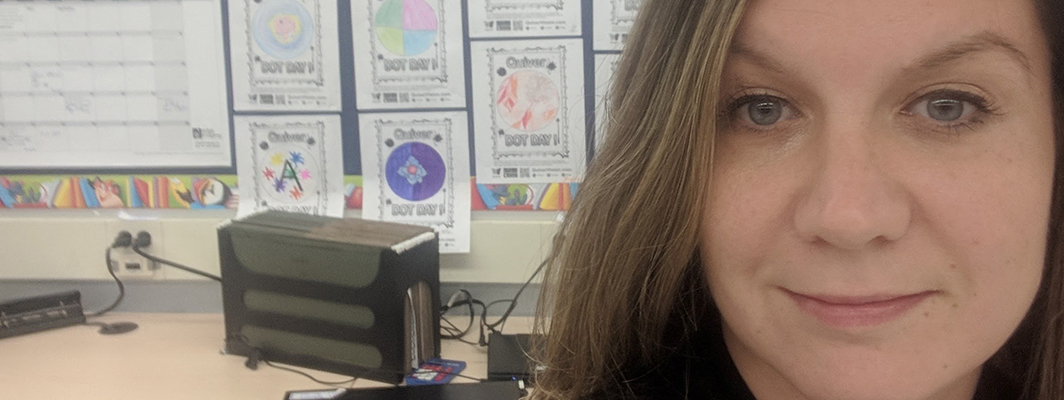
Five years ago, Kristine was invited to a webinar with Microsoft about integrating education and technology. During that call, she listened attentively to a speaker discuss a project that provided education to those living in Kakuma Refugee Camp. Having just finished reading the novel ‘A Long Walk to Water’ with my class, she was very familiar with Kakuma Refugee Camp. Kakuma houses over 200,000 refugees who have fled war and famine in Sudan, Somalia, and Burundi, to name a few. 55% of the refugees are children and the schools in the camp had over 200 students with no access to educational resources or textbooks. Learning this, I wanted to do whatever I could to help.
A Skype call was then arranged with Alex Moses from Film Aid Kakuma and my students developed plans for fundraising efforts. At home, I started to read about the camp and picked up the book ‘Kakuma Girls’ to understand more about their situation. My students and I sent Skype messages to develop a connection with the students in the camp and we donated $500 to the Kakuma Project for laptops. This was my first global project and it truly felt like we were making a difference. It was at this point that I noticed a transformation in my pedagogy. A shift to global service learning!
“I think it is important to challenge and stimulate my students’ minds to achieve their goals. By doing so, I feel I am in a position to plant the seeds of learning for their posterity. In other words, these students, given proper encouragement and direction have the potential to become technological leaders and innovators. The learning environment that I have created supports independent learning and inquiry. Students are encouraged to pursue their own passion projects with guidance and direction from the teacher. By giving students voice and choice in their learning they are able to tap into their individual skill sets and strengths while researching a topic of personal interest.
The learning environment is collaborative, inquisitive, and sometimes noisy and messy. I strongly encourage my students to have an untethered mind when formulating an idea or concept. The technology used in my classroom ranges from low tech (e.g., cardboard, MakeDo kit, recyclable materials, etc.) to high tech (AR/VR, 3D Printing, Minecraft, Tinkercad, Microbit, Raspberry Pi, Scratch, etc.) providing multiple points of entry and extension opportunities, plugged and unplugged activities.”
“Launch: Using Design Thinking to Boost Creativity and Bring Out the Maker in Every Student by John Spencer and A.J. Juliani. Launch provides a framework for design thinking and how to get the most out of the creative process. It introduces the Launch Cycle and is filled with practical step-by-step advice on how to boost creativity in the classroom.”
“My students are engaged in learning about their local environment around their school. The class organized a ‘Walk for Water’ to the Credit River to learn more about the sacred and scarce resources. Students engage in local water testing at our school and use Skype to share their findings with other schools in Ontario and Manitoba. After sharing their findings with other classes, they have a Skype session with an Indigenous elder to help deepen their learning experience! Students conduct a bio-survey of the woodlot on their school site to research invasive species. They conduct a ‘Soil My Undies’ experiment to test local soil health as part of their work on the climate action project. The class is chosen to represent Canada during the inaugural Climate Action Day webinar featuring David Attenborough and Jane Goodall. Students even received special recognition from Her Majesty the Queen!”
“Sometimes we have to look beyond the four walls of our classrooms to engage the students in powerful learning experiences. Getting outdoors, looking for experts outside of the building, and connecting students with authentic service learning projects really promotes student engagement. Think local, in order to act globally. When we try to solve the world’s problems it may at first appear a daunting task, but if we can each make a difference in our local communities this momentum can spread and have lasting impacts.
Achieving the UN Sustainable Development Goals is not for the faint of heart. Students participating in global projects and service-learning like the Climate Action Project are helping to build bridges between the global and the local, revealing our shared responsibility for this planet, and demonstrating that we are stronger when we work together!”
“You are interested in learning more about how to incorporate space education in lesson planning, climate change teaching, e-sports, VR/AR, AI, and implementing service-learning projects. If you are curious about some of the global educational projects that are available I would be happy to share the details on how you can get involved!”
Learn more about HP Teaching Fellows.
